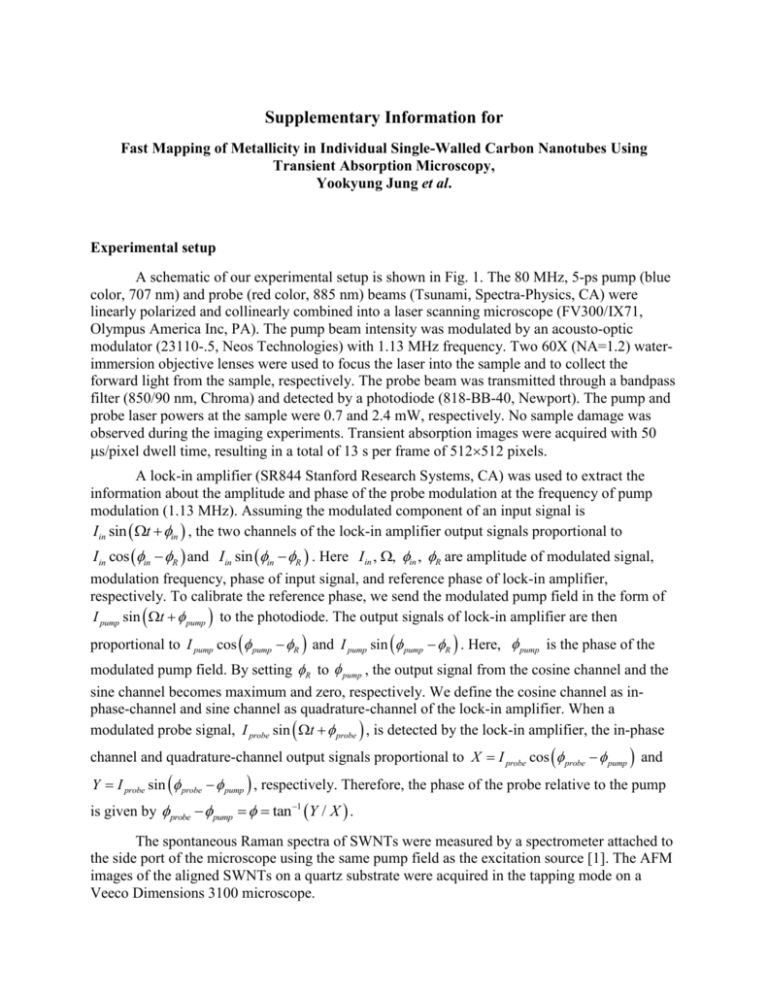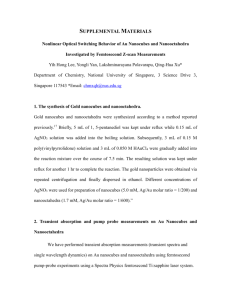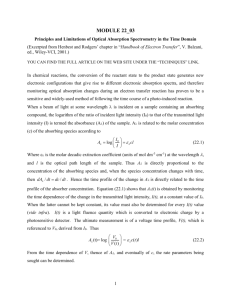Supplementary_Information_revised_9.13.2010
advertisement

Supplementary Information for Fast Mapping of Metallicity in Individual Single-Walled Carbon Nanotubes Using Transient Absorption Microscopy, Yookyung Jung et al. Experimental setup A schematic of our experimental setup is shown in Fig. 1. The 80 MHz, 5-ps pump (blue color, 707 nm) and probe (red color, 885 nm) beams (Tsunami, Spectra-Physics, CA) were linearly polarized and collinearly combined into a laser scanning microscope (FV300/IX71, Olympus America Inc, PA). The pump beam intensity was modulated by an acousto-optic modulator (23110-.5, Neos Technologies) with 1.13 MHz frequency. Two 60X (NA=1.2) waterimmersion objective lenses were used to focus the laser into the sample and to collect the forward light from the sample, respectively. The probe beam was transmitted through a bandpass filter (850/90 nm, Chroma) and detected by a photodiode (818-BB-40, Newport). The pump and probe laser powers at the sample were 0.7 and 2.4 mW, respectively. No sample damage was observed during the imaging experiments. Transient absorption images were acquired with 50 s/pixel dwell time, resulting in a total of 13 s per frame of 512512 pixels. A lock-in amplifier (SR844 Stanford Research Systems, CA) was used to extract the information about the amplitude and phase of the probe modulation at the frequency of pump modulation (1.13 MHz). Assuming the modulated component of an input signal is Iin sin t in , the two channels of the lock-in amplifier output signals proportional to Iin cos in R and Iin sin in R . Here Iin , , in , R are amplitude of modulated signal, modulation frequency, phase of input signal, and reference phase of lock-in amplifier, respectively. To calibrate the reference phase, we send the modulated pump field in the form of I pump sin t pump to the photodiode. The output signals of lock-in amplifier are then proportional to I pump cos pump R and I pump sin pump R . Here, pump is the phase of the modulated pump field. By setting R to pump , the output signal from the cosine channel and the sine channel becomes maximum and zero, respectively. We define the cosine channel as inphase-channel and sine channel as quadrature-channel of the lock-in amplifier. When a modulated probe signal, I probe sin t probe , is detected by the lock-in amplifier, the in-phase channel and quadrature-channel output signals proportional to X I probe cos probe pump and Y I probe sin probe pump , respectively. Therefore, the phase of the probe relative to the pump is given by probe pump tan 1 Y / X . The spontaneous Raman spectra of SWNTs were measured by a spectrometer attached to the side port of the microscope using the same pump field as the excitation source [1]. The AFM images of the aligned SWNTs on a quartz substrate were acquired in the tapping mode on a Veeco Dimensions 3100 microscope. Sample preparation For the phase images of s-SWNTs and m-SWNTs shown in Fig. 1, 95% pure m-SWNTs and s-SWNTs (Nanointegris Inc.) were spin-coated on a coverslip. The diameter range is 1.2 ~ 1.7 nm for both s-SWNTs and m-SWNTs. For the aligned SWNTs sample, special-cut quartz substrate with patterned Fe catalyst was first annealed for 1 hour in air at 900 ºC. Then, the sample was heated to 900 ºC in hydrogen (800 sccm), followed by chemical vapor deposition growth process at 900 ºC under a flow of methan (1900 sccm) and hydrogen (300 sccm) [2]. Thermal lens effect Because nanotubes effectively convert near infrared light into heat, we have studied the thermal lens effect [3-5] that may coexist with the transient absorption process. Because the thermal lens contribution is known to change its sign across the focus, we checked the dependence of the signal on the axial focal position. The z-position dependences of the signal from m-SWNTs are shown in Fig. S1. The pump wavelength was 885 nm and the probe wavelengths were 780 nm and 707 nm, respectively. When the probe energy (707 nm) is in resonance with the energy gap of the m-SWNTs, no sign dependence on z was observed (Fig. S1(a)). Throughout the z scanning, the m-SWNTs show positive signals corresponding to inphase transient absorption. When the probe energy (780 nm) is far away from the resonance of the m-SWNTs, the phase shows dependence on the z-position indicating the existence of a thermal lens effect (Fig. S1(b)). The maximal thermal lens signal is obtained at z = ± 300 nm and is about 17% of the transient absorption signal at resonance. In our transient absorption imaging experiments, we have placed the SWNTs in the focal center where the transient absorption signal is maximized and the thermal lens effect is close to zero (Fig. S1(b)). 12 Probe 707 nm 4 0 -4 -8 -12 8 Signal (a.u.) Signal (a.u.) 8 12 (a) (b) Probe 780 nm 4 0 -4 -8 -2 -1 0 1 Z position (m) 2 -12 -2 -1 0 1 2 Z position (m) FIG. S1. Dependence of the pump-probe signal on the z-position of SWNTs. (a) Z-position dependence of the pump-probe signal with the probe wavelength at 707 nm (on resonance with the energy gap of the m-SWNTs). (b) Z-position dependence of the pump-probe signal with the probe wavelength at 780 nm (off resonance with the energy gap of the m-SWNTs). At z=0, the transient absorption signal is maximized whereas the thermal lens signal is nearly zero. Dependence of the pump-probe signal on Raman shifts The pump-probe imaging setup was used for stimulated Raman scattering (SRS) microscopy [6]. The stimulated Raman scattering occurs when the energy difference between pump and probe matches a Raman mode of the material. To inspect the contribution of SRS in the transient absorption images, dependence of the signal on the Raman shift was studied at zero time delay and the results are shown in Fig. S2. The in-phase-channel image of the s-SWNTs is shown in Fig. S2(a). The wavelengths of the pump and the probe were tuned to 738.01 and 835.91 nm, respectively, which corresponds to an energy difference of 1587 cm-1 close to the G+ band of the s-SWNTs. The in-phase-channel image of s-SWNTs with the Raman shift at 1416 cm-1 is shown in Fig. S2(b). The wavelengths of the pump and the probe were 747.44 and 835.91 nm, respectively. The in-phase-channel images show little dependence on the Raman shift, suggesting the contribution of SRS is negligible in the case of s-SWNTs. (a) pump probe Raman shift 738.01 nm 835.91 nm 1587 cm-1 (b) pump probe Raman shift 747.44 nm 835.91 nm 1416 cm-1 +1 0 5 µm -1 FIG. S2. The transient absorption signal is independent of the Raman shift. (a), (b) The transient absorption images of a single s-SWNT at the Raman shift of 1587 cm-1 and 1416 cm-1, respectively. Time-resolved measurements We studied the transient absorption signal in the time domain by varying the time delay between the pump and the probe pulses. The signals shown in Fig. S3(a) and S3(b) were measured from the in-phase-channel of the lock-in at different delay times. The wavelengths of the pump and probe fields were 707 nm and 885 nm, respectively. In Fig. S3(a), the signal shows the two distinctive decays. The first one is an instantaneous decay within the laser pulse width of 5 ps and the second one can be fitted with an exponential decay with a decay time of 33 ps. It is known that the rapid decay arises from the electron-electron interaction, and the slow decay is caused by the electron-phonon interaction [7] and interband carrier recombination [8]. In the pump-probe experiment, the pump field induces a non-equilibrium state of the electrons in the SWNT. The electron-electron interaction leads to internal thermalization within sub-ps time scale, and the following electron-phonon interaction cools the electron gas to the lattice temperature with the ps time scale. In our case, the measurement of the rapid e-e thermalization time is limited by the 5 ps duration of the laser pulse. The signal from the m-SWNT also shows a rapid and a slow decay, like the s-SWNT. However, the rapid decay component of the m-SWNT is not as prominent as the s-SWNT. A possible mechanism accounting for the different transient absorption dynamics is the stimulated emission in s-SWNTs. (a) S-SWNT 8 (b) M-SWNT 0 Signal (a.u.) Signal (a.u.) 12 -4 4 -8 0 -20 0 20 40 60 80 100 120 Time delay (ps) -20 0 20 40 60 80 100 120 Time delay (ps) FIG. S3. Dependence of the in-phase-channel signal on time delay between pump and probe. The pump and probe wavelengths are 707 nm and 885 nm, respectively. The solid squares are experimental data. The red curves represent least-squares fitting with a Gaussian function for the fast decay component and an exponential function for the slow decay component. Transient absorption imaging of m-SWNTs with the pump filed in resonance with E11M With the pump field at 885 nm and the probe field at 707 nm, the m-SWNTs show positive contrast in the in-phase-channel image (Fig. S4(a)) and little contrast in the quadraturechannel image (Fig. S4(b)). These signals from the m-SWNTs have the phase of 0°, which corresponds to an in-phase probe modulation (negative transient absorption) relative to the modulation of the pump field. In Fig. S4(c), all the m-SWNTs are indicated with a blue color. This result is opposite to the one with 707-nm pump and 885-nm probe at Fig. 2(d)-(f). This inphase signal indicates a decrease of probe absorption by the m-SWNTs near the E11M -transition peak located around 700 nm (Fig. 4(a)). In Fig. S4(d), the in-phase-channel signal from the mSWNT shows an instantaneous decay within the pulse width of 5 ps and a slow decay with the decay time of 42 ps. In-phase-channel (c) (d) 8 Signal (a.u.) (a) Phase Quadrature-channel (b) data fitting 6 4 2 0 -20 0 20 40 60 Time delay (ps) 80 100 FIG. S4. Transient absorption images of the m-SWNTs acquired with a pump field at 885 nm and a probe field at 707 nm. (a), (b) In-phase and quadrature-channel image of m-SWNTs, respectively. (c) Pump-probe phase image of the m-SWNTs. (d) Dependence of in-phasechannel signal from the m-SWNTs on the time delay between the pump and the probe. Dependence of transient absorption signal on pump and probe power To obtain a deeper understanding of the origin of the transient absorption signal, the signal dependence on the pump and probe powers was investigated. The transient absorption signal from a single s-SWNT was measured at zero time delay between the pump and the probe beam. The data is fitted with the saturation equation, Ax/(1+x/xs), where, A is a constant, x is an input power and xs represents a saturation power. For the fixed probe power of 1.8 mW, the transient absorption signal starts to show saturation when the pump power is larger than 1.9 mW (Fig. S5(a)). The saturation of the transient absorption signal at high pump power suggests that the ground state bleaching contributes to the in-phase signal from s-SWNTs. The dependence of the transient absorption signal on the probe power also shows saturation (Fig. S5(b)). For the fixed pump power of 0.96 mW, the transient absorption signal starts to saturate when the probe power is over 5.8 mW. (a) Probe Power 1.8 mW 0.9 0.6 0.3 0.0 0 1 Pump Power 0.96 mW 1.2 Signal (a.u.) 1.2 Signal (a.u.) (b) 1.5 1.5 2 3 Pump power (mW) 4 0.9 0.6 0.3 0.0 0 1 2 3 4 5 6 Porbe power (mW) FIG. S5. Dependence of the transient absorption signal from a single SWNT on the pump and probe powers. (a) Transient absorption signal versus input pump power, with the probe power fixed to 1.8 mW. Saturation of the transient absorption signal was observed when the pump power was over 1.9 mW (b) Transient absorption signal versus input probe power, with the pump power fixed to 0.96 mW. Saturation of the transient absorption signal was observed when the pump power was over 5.8 mW. The solid squares are experimental data. The red curves represent fitting with the saturation equation, A x/(1+x/xs). Here, A is a constant, x is the input power, and xs represents the saturation power. Transient absorption imaging of aligned individual SWNTs Transient absorption images of aligned individual SWNTs are shown in Fig. S6. The inphase and quadrature channel images are shown in Fig. S6(a) and S6(b), respectively. In Fig. S6(a), both Fe catalyst pads and SWNTs can be observed. While the Fe pads show signals with negative sign, SWNTs show both negative and positive-signed signal. Figure S6(b) shows mere noise indicating that the positive and the negative signal of Fig. S6(a) are purely in-phase and anti-phase signals, respectively. The conventional transmission image (Fig. S6(c)) gives no contrast of the SWNTs. In the transmission image, only markers with cross shape are observed. The enlarged image of the dotted square in Fig. S6(a) is shown in Fig. S6(d). In this image, several SWNTs with similar length can be observed. While most show positive signal, one SWNT show weak negative signal. Broken SWNTs with shorter length and aggregation of SWNTs are also observed. (a) (b) +1 +1 0 50 µm (c) 0 50 µm -1 -1 (d) +1 0 50 µm 10 µm -1 FIG. S6. Large-view transient absorption image of aligned SWNTs. (a), (b) In-phase and quadrature-channel image of the aligned SWNTs (c) transmission image of the corresponding area. (d) enlarged image of the dotted square in Fig. S6(a). References [1] [2] [3] [4] [5] [6] [7] [8] M. N. Slipchenko et al., J. Phys. Chem. B 113, 7681 (2009). S. Kang et al., Nature Nanotech. 2, 230 (2007). M. Harada et al., Anal. Chem. 65, 2938 (1993). K. Uchiyama et al., Jpn. J. Appl. Phys. 39, 5316 (2000). S. Hiki et al., Anal. Chem. 78, 2859 (2006). C. W. Freudiger et al., Science 322, 1857 (2008). T. Hertel, R. Fasel, and G. Moos, Appl. Phys. A-Mater. 75, 449 (2002). G. N. Ostojic et al., Physical Review Letters 92, 117402 (2004).






